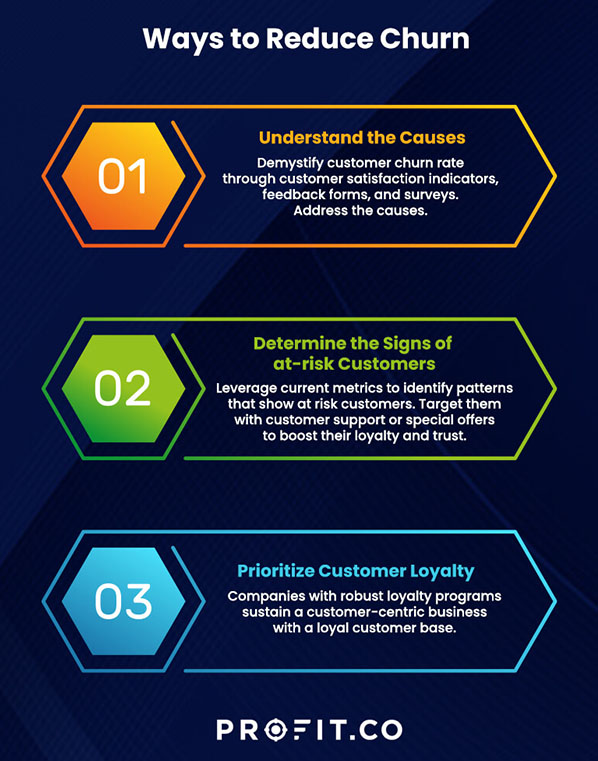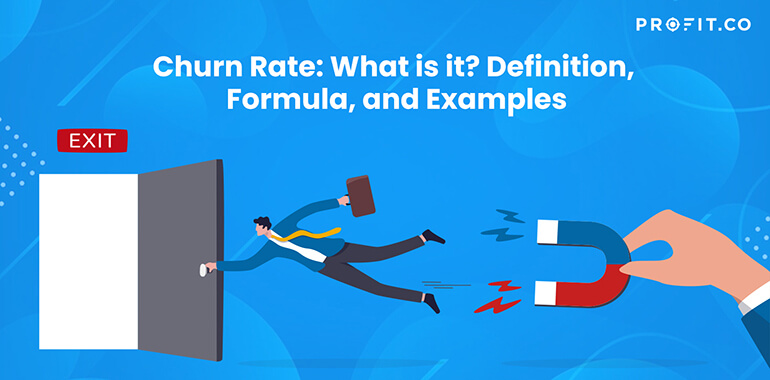The churn rate is a percentage of the number of people who discontinue their business with you over a given period. It also refers to the rate employees leave your company over a certain period.
Calculating churn allows you to monitor your business’s performance and growth. Even low churn rates can significantly affect the long-term revenue your business generates.
Let’s explore the churn rate, why it matters, the calculation, and how to keep it under control.
What is Churn Rate?
Churn rate is an essential metric for businesses where customers complete payments regularly. If quality customers don’t stay long enough for you to recover your customer acquisition cost (CAC), your business is in trouble regardless of your monthly income.
Although it sounds like a scary metric, the churn rate is vital to your company or business. If you have no idea how many customers you’re losing, you won’t realize how it’s affecting your business. It also won’t be possible to develop and implement improvement plans to minimize your turnover rates.
We see our customers as invited guests to a party, and we are the hosts. It’s our job every day to make every important aspect of the customer experience a little bit better.
Churn Rate Definition
Customer churn rate is the percentage of subscribers or customers who cancel or stop doing business with you over a particular period. The nature of your business will determine the appropriate period to track your churn rate.
In reality, it’s inevitable for customers to leave. Combining the churn rate and other customer retention metrics makes it easier to evaluate your brand performance and the areas to improve.
To enhance your customer experience using metrics You can get started on Profit.co completely free today!
Why is Churn Rate Important?
Customers are the backbone of any business. Understanding your churn rate is essential to ensure you adapt to the dynamic market needs as you grow.
A high churn rate indicates you may be spending a lot of revenue on customer acquisition but not receiving the maximum ROI. Determining the problem areas will help you improve user retention and long-term revenue.
Generally, acquiring new customers is more expensive than retaining existing ones. Besides the lost revenue, high churn rates come with an extra cost of finding new customers.
Although it can be intimidating, understanding your churn rate is an excellent way to enhance your business. It’s also an effective way to nurture profitable long-term relationships with your customers.

Calculation
There are various ways to calculate churn, often indicated as the percentage of customers lost over a given period. You’ll need to know the customers you had at the start of the period, like one month, for instance, and the customer left at the end.
It serves as a predictor that represents the number of customers you may lose in the future if you don’t adjust some strategies.
Churn Rate Formula
The simplest formula you can use to calculate your churn rate is:
(A/B) x 100 = C
- A = The initial number of customers you have at the beginning of the period.
- B = Number of customers you lost during this period
- C = Churn rate as a percentage
How Do You Calculate the Churn Rate?
You can use the simple formula to calculate the churn rate for any period, whether a day, week, month or year. However, high-growth businesses or companies need a more complex formula for a more realistic image of the churn rate.
For instance, when scaling your business, the high number of new customers sometimes offsets the number of customers leaving. In such a case, using the simple Churn Rate Formula would be inaccurate because they only consider the lost customers.
The adjusted churn rate formula is:
(C / [(A+B) / 2]) x 100 = D
- A = The initial number of customers at the beginning of the period
- B = Total number of customers at the end of the given period
- C = Total number of churned customers during this period
- D = Churn rate as a percentage
Most companies have slow periods at certain times of the year. For instance, people are more likely to rent ski equipment when there’s lots of snow in winter.
You also need to consider seasonality when determining your churn rate. You can use the simple formula to calculate your churn rates during high and low seasons.
You’ll use these values in the seasonal churn rate formula to calculate your annual churn rate.
The seasonal churn rate formula is:
{[ (A x B) + (C x D) ] / (A+C)} x 100 = E
- A = The total number of customers during the high period
- B = The churn rate during the high period
- C = The total number of customers during the low period
- D = The churn rate during the low period
- E = Annual churn rate percentage
Not all customers generate equal revenue because some customers pay more or buy more frequently. Calculating your revenue churn rate can give you a better picture of how your customer churn affects your bottom line.
The revenue churn rate formula is similar to the simple churn rate formula. The difference is that the revenue we consider is the customer totals.
The revenue churn rate formula is:
(A/B) x 100 = C
- A = Churned revenue
- B = Total revenue
For instance, if your total revenue for a certain period was $100,000, but you lost $20,000, your calculation will be:
20,000 / 100,000 X 100 = 20%
In this revenue Churn Rate Example, your business has a 20% churn rate.
How Can You Keep Churn Rate Under Control?
Understanding your customer churn rate is a vital first step. Now it’s time to figure out ways to reduce the churn and expand your business.
- Understand the Causes
- Determine the Signs of at-risk Customers
- Prioritize Customer Loyalty
Customers leave for various reasons, some of which are genuine, while some seem to be specific to a particular customer. The easiest way to demystify your customer churn rate is by asking customers what they dislike or like about your brand.
You can achieve this through customer satisfaction indicators, feedback forms, and surveys.
It’s also essential to consider internal metrics along the customer journey. If you have an e-commerce platform, you can check how easy it is to search for products and the average shipping time.
Part of effective customer retention involves understanding which customers have a high likelihood of leaving. You can use your current metrics to identify patterns that may show a customer is at risk of departing.
Once you identify at-risk customers, you can target them with exceptional customer support or special offers to boost their loyalty and trust.
It’s essential to give at-risk customers incentives to stay, but don’t forget to reward the loyal customers present from the start.
The Harvard Business Review highlights that companies with robust loyalty programs grow about two and a half times faster than those without. Such programs allow you to sustain a customer-centric business while enticing customers with offers to look forward to.
FAQs
1. What Is a Good Churn Rate?
In reality, a business can’t have a zero churn rate. Generally, average churn rates range between 2% and 8% of your Monthly Recurring Revenue (MRR). Healthy churn rates should be around 2%, although the age of your business or company can contribute. Businesses over ten often have churn rates between 2-4%, while newer companies average about 4- 24%.
2. What Does a High Churn Rate Indicate?
A high churn rate shows that your business loses more quality customers than it gains. It may be due to poor customer service, quality, or other unfavorable aspects.
3. What is the Difference Between Churn and Attrition?
Customer attrition, churn, and customer turnover refers to the same thing.
Conclusion
Customer expectations and buying behaviors are often dynamic in the current competitive market. Any business needs to track customer churn rates to evaluate its performance. This data helps you assess customer satisfaction and gives valuable insights into how customers feel about your brand. It empowers you to take practical steps towards enhancing your products, customer service, and business practices. Organizations can use a customer experience centered strategy and diligently follow through on execution by tracking its progress . Book a free demo with our team to learn more about Profit.co’s OKR platform integrated with performance management to improve productivity in your organization through enhanced customer service.

